Questioning Behavior-Based Safety
Does Behavior-Based Safety Reduce Occupational Injuries?
Background
For the past 20 years I have worked in both general industry and construction. I have searched for the program that will reduce – and ultimately eliminate – occupation injuries. I have yet to find the program and like all of us in the safety profession, I continue to search. In March I attended the Construction Safety Council’s annual Construction Expo and Safety Conference. While there, I was able to catch up with some safety professionals to discuss the successes and failures we have experienced. As we threw ideas around for discussion, a program that continued to bubble to the surface was behavior-based safety (BBS). I am not a detractor of the BBS idea – anything that reduces injuries I am in favor of – however, I have never been a proponent of BBS either.
BBS was first addressed by E. Scott Geller in 1979[i]. According to Geller, at its core the BBS process is “to get people to change what they do”[ii]. The BBS process focuses on the human side of behavior, defines safe and unsafe behaviors, and is an organized process to effect change within a workforce[iii]. To facilitate the BBS process an observer observes an employee’s behavior while performing tasks and documenting the results on an assessment survey. After the task is completed, the assessment survey is reviewed with the employee for input and feedback. After this review is complete, the results of the observation are shared with a management team, which will include subject matter experts (ie: individuals experienced with the process). At the completion of this process, the unsafe behavior(s) are cataloged and the results are communicated with the workforce[iv].
Discussion
Behavior-based safety seems like a straightforward process that many safety professionals would like in their collection of safety programs: behavior is observed, documented, and reviewed. Why then does BBS elicit so much discussion? Does the BBS process really reduce injuries, or does it reduce the reporting of injuries?[v] Are the high costs and sustainability issues associated with BBS programs a deterrent to its use?[vi]
I have tried BBS in one form or another and I am still not certain if it is effective. One thing I do know, we as safety professionals must find something to reduce occupational injuries – and working at that goal for another 20 years is not an option!
Please provide comments, examples, successes and failures. Remember, this blog is intended to be an interactive forum for safety- and non-safety professionals.
[i] Atkinson, W. (May 2010). Behavior-based safety. Retrieved from http://precast.org/2010/05/behavior-based-safety/
[ii] Geller, E. S. (September 2001). Sustaining participation in a safety improvement process: 10 relevant principles from behavioral science. Professional Safety. 46(9). 24-29.
[iii] Eckenfelder, D. J. (September 2003). Why we need an antidote for behavior-based safety. Occupational Hazards, 65(9), 98-106.
[iv] Choudhry, R. M., Fang, D., & Mohamed, S. (October 2007). Journal of Management in Engineering, (23)4, 207-212.
[v] Agnew, J. & Ashworth, C. (2012). Behavior-based safety: Setting the record straight. Retrieved from http://aubreydaniels.com/pmezine/behavior-based-safety-setting-record-straight and Choudhry et. al.
[vi] Austin, J. (2006). An introduction to behavior-based safety. Stone, Sand and Gravel Review, January/February and Eckenfelder.














